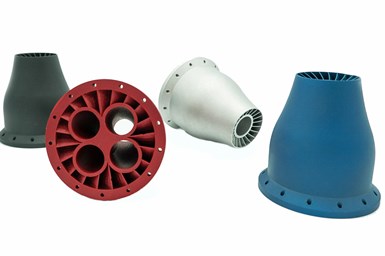EOS Aluminum Al5X1 Is High-Strength Anodizable Alloy for Industrial 3D Printing
The aluminum alloy offers light weight, high strength, elongation and corrosion resistance.
EOS’ Aluminum Al5X1 is an aluminum alloy engineered specifically for additive manufacturing (AM), but at a more competitive cost than other aluminum alloys with similar strength and elongation properties. The EOS Aluminum Al5X1 delivers excellent performance and material properties with a combination of high strength and elongation, around 410 MPa UTS and 14% elongation.
Requiring only a single-step heat treatment with no Hot Isostatic Pressing (HIP), organizations can manufacture parts faster and at a lower total cost. The 3D printed applications using EOS Aluminum Al5X1 can also be electropolished and anodized (Type II and Type III) for both cosmetic (colored) and corrosion-resistant protective properties. There are no limits to potential color choices, which could be important to consumer-facing products.
EOS Aluminum Al5X1 was tested by multiple organizations, including leading semiconductor, aerospace and defense companies. Early adopters have noted the material’s exceptional performance combined with the competitive cost-per-part (CPP) has created a strong business case for production implementation.
“Since early 2023, we have been working to develop Al5X1 performance data and material allowables on behalf of our prime customers,” says Brian Neff, Sintavia founder and CEO, a designer and additive manufacturer of mechanical systems for the aerospace and defense industry. “Preliminary results are very promising, and we look forward to introducing Al5X1 across our thermodynamic product lines. Developing a higher performing aluminum alloy is of critical importance not only to us, but also to the industry as a whole.”
A combination of high strength and high elongation for an aluminum alloy is critical for manufacturers in industries like aerospace. “But equally crucial is delivering the property combination at a reasonable cost,” says Dr. Ankit Saharan, EOS senior manager of metals technology. “Also interesting is that since the material can be anodized, this makes it very attractive to OEMs in areas like consumer electronics who are seeking to produce different colored products to suit customers’ preferences, with the added bonus of corrosion resistance.”
- Read about EOS developing sustainable polymers for additive manufacturing. The climate-neutral PA 1101 and carbon-reduced PA 2200 polymer materials are designed to increase production efficiency, while supporting more sustainable additive manufacturing.
- Learn about the EOS collaboration with nTop to create file capability that would limit design data bottlenecks. EOS and nTop have created a new nTop Implicit File that can result in up to 99% smaller file sizes, 500 times faster file generation and 60% faster load time, making it more readily available to additive manufacturing build preparation software for manufacturing.
Related Content
VulcanForms Is Forging a New Model for Large-Scale Production (and It's More Than 3D Printing)
The MIT spinout leverages proprietary high-power laser powder bed fusion alongside machining in the context of digitized, cost-effective and “maniacally focused” production.
Read MoreAdditive Manufacturing Is Subtractive, Too: How CNC Machining Integrates With AM (Includes Video)
For Keselowski Advanced Manufacturing, succeeding with laser powder bed fusion as a production process means developing a machine shop that is responsive to, and moves at the pacing of, metal 3D printing.
Read MoreAM 101: NanoParticle Jetting (NPJ)
The proprietary process from XJet builds ceramic and metal parts using nanoparticle suspensions. Learn how NPJ works in this introductory article, part of our AM 101 series.
Read MorePostprocessing Steps and Costs for Metal 3D Printing
When your metal part is done 3D printing, you just pull it out of the machine and start using it, right? Not exactly.
Read MoreRead Next
3D Printing Brings Sustainability, Accessibility to Glass Manufacturing
Australian startup Maple Glass Printing has developed a process for extruding glass into artwork, lab implements and architectural elements. Along the way, the company has also found more efficient ways of recycling this material.
Read MoreAt General Atomics, Do Unmanned Aerial Systems Reveal the Future of Aircraft Manufacturing?
The maker of the Predator and SkyGuardian remote aircraft can implement additive manufacturing more rapidly and widely than the makers of other types of planes. The role of 3D printing in current and future UAS components hints at how far AM can go to save cost and time in aircraft production and design.
Read More4 Ways the Education and Training Challenge Is Different for Additive Manufacturing
The advance of additive manufacturing means we need more professionals educated in AM technology.
Read More








.png;maxWidth=300;quality=90)












